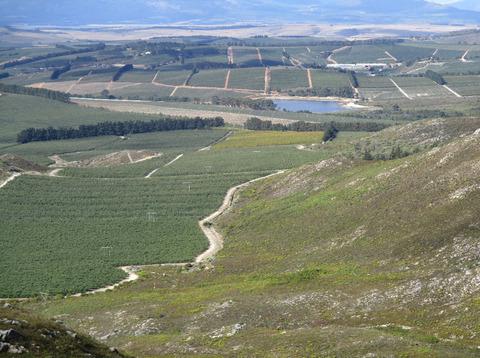当前位置:
X-MOL 学术
›
J. Appl. Ecol.
›
论文详情
Our official English website, www.x-mol.net, welcomes your feedback! (Note: you will need to create a separate account there.)
Spillover of terrestrial arthropod species and beta diversity in perennial crops relative to spatial scale of land‐use intensity
Journal of Applied Ecology ( IF 5.7 ) Pub Date : 2020-05-08 , DOI: 10.1111/1365-2664.13638 Julia van Schalkwyk 1 , James S. Pryke 1 , Michael J. Samways 1 , René Gaigher 1
中文翻译:

相对于土地利用强度的空间尺度,多年生作物中陆生节肢动物种类的溢出和β多样性
更新日期:2020-05-08
Journal of Applied Ecology ( IF 5.7 ) Pub Date : 2020-05-08 , DOI: 10.1111/1365-2664.13638 Julia van Schalkwyk 1 , James S. Pryke 1 , Michael J. Samways 1 , René Gaigher 1
Affiliation

|
- Arthropod diversity in agricultural areas is influenced by land‐use intensity (LUI) at both local and landscape scales. In agricultural systems, non‐crop habitats are important for promoting in‐field arthropod diversity, although in perennial orchard systems, boundary contrast (i.e. structural differences between crop and non‐crop habitats) may impede spillover of arthropods from non‐crop areas.
- We focus on ground‐dwelling arthropods sampled within orchards in the Kogelberg Biosphere Reserve, South Africa, that do not show a strong association with this habitat type (i.e. ‘non‐cultural’ species), and assess the influence of local (in‐field scale; FLUI) and landscape scale LUI (LLUI), boundary contrast, cover‐crop management, and population effects on species richness, assemblage variation within orchards, and the dissimilarity between assemblages in crop and non‐crop habitats (i.e. ‘cross‐edge dissimilarity’).
- Higher LLUI (lower amounts of non‐crop habitat) was associated with higher in‐field species richness but also higher cross‐edge dissimilarity (i.e. these habitats were more distinct in certain landscapes). FLUI was important for non‐cultural species, especially non‐cultural predators and detritivores, for which higher levels of fertilization reduced in‐field species richness. Reduced contrast enhanced in‐field species richness, but there was limited evidence that this enhanced spillover from non‐crop habitats.
- Synthesis and applications. In production systems with high border contrast and highly productive crop habitats, higher landscape scale land‐use intensity can enhance in‐field diversity. By supporting a subset of the assemblage able to thrive in both crop and non‐crop habitats, this is contributing to community divergence. To promote farmland diversity, we advocate the reduction of agrochemical inputs, production diversification at the landscapes scale, and the incorporation of a network of non‐crop corridors and stepping‐stone habitats to maintain connectivity and resilience across the landscape.
中文翻译:

相对于土地利用强度的空间尺度,多年生作物中陆生节肢动物种类的溢出和β多样性
- 农业区域节肢动物的多样性受当地和景观尺度上土地利用强度(LUI)的影响。在农业系统中,非作物生境对于促进田间节肢动物多样性很重要,尽管在多年生果园系统中,边界对比(即作物和非作物生境之间的结构差异)可能会阻碍节肢动物从非作物区域溢出。
- 我们专注于在南非Kogelberg生物圈保护区的果园中采样的地面节肢动物,这些节肢动物与这种栖息地类型(即“非文化”物种)没有强相关性,并评估了当地(田间)的影响尺度; FLUI)和景观尺度LUI(LLUI),边界对比,覆盖作物管理以及种群对物种丰富性的影响,果园内组合的变化以及农作物和非作物生境的组合之间的差异(即“交叉边缘”差异”)。
- 较高的LLUI(较少的非作物生境)与较高的田间物种丰富度有关,但也与较高的跨界异质性有关(即,这些生境在某些景观中更为明显)。FLUI对于非文化物种特别是非文化捕食者和有害生物非常重要,因为较高的受精量会降低田间物种的丰富度。降低的对比度增强了田间物种的丰富度,但是仅有有限的证据表明,这种增强增强了非作物生境的溢出。
- 综合与应用。在边界对比度高和作物生境生产力高的生产系统中,较高的景观规模土地利用强度可以增强田间多样性。通过支持能够在农作物和非农作物生境中a壮成长的种群中的一部分,这有助于社区分化。为了促进农田的多样性,我们主张减少农用化学品的投入,在景观尺度上实现生产多样化,并纳入非农作物走廊和垫脚石栖息地网络,以保持景观的连通性和适应力。


























 京公网安备 11010802027423号
京公网安备 11010802027423号